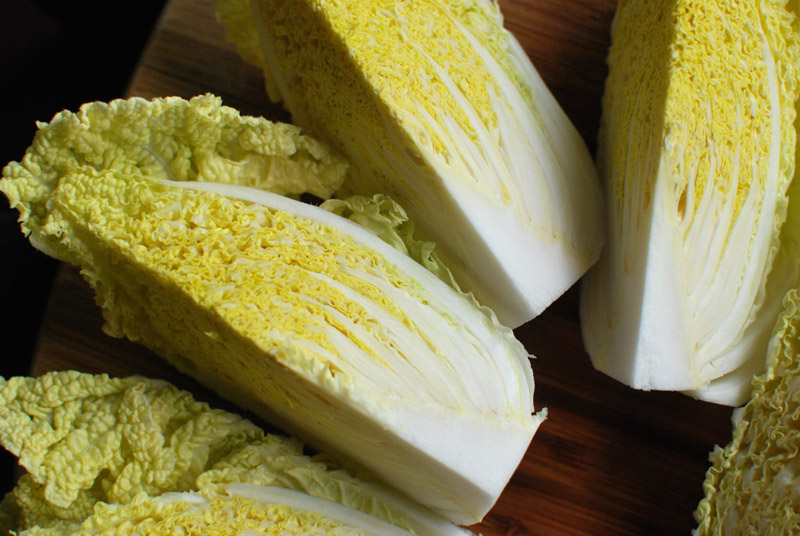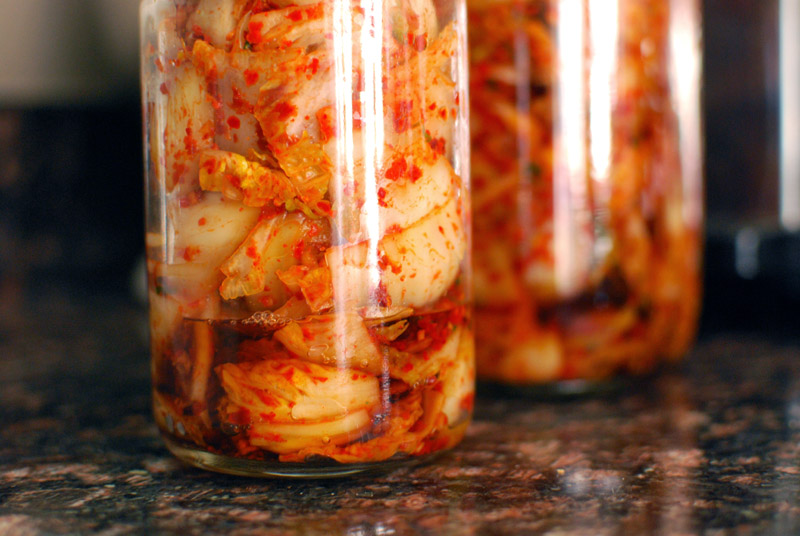Yes, I’ve posted about kimchi before. But for all its ease, and as much as I enjoy that recipe, that was ersatz kimchi, whipped together in a few hours and not even fermented. Horrors, I know.
After a recent wedding in my boyfriend’s family, and the related chance to chat with his charming Korean cousin, I realized that it had been far too long since I’d had a batch of kimchi in my fridge. I also knew that if I didn’t at least attempt a properly-made version, I’d have to explain myself sooner or later. My culinary pride was at stake.
One major flaw with my previous go-to recipe was the absence of gochugaru, Korean chili flakes. I had convinced myself that they couldn’t possibly be that much different from standard crushed red pepper flakes, but my heart of hearts knew I was fooling myself.
I found a reputable Korean market here in the city, and discovered how wrong I had been. Despite their incarnadine brilliance, gochugaru are far less spicy than the comparatively drab red pepper flakes. And because of this lack of palate-numbing capsaicin, the true flavor of the chilies really shines. The flavor is bright and rich, fruity and robust at the same time. It’s revelatory.
Also due to the lower capsaicin levels of these chili flakes, it becomes necessary to use more of them to get a decent level of heat. And by “more”, I mean a lot more. A heckuva lot more. For example, I used 3/4 cup in this recipe, and I think the kimchi could stand to be spicier. This makes it more of a session kimchi, though, one you can eat a whole plate of. It’s not going to burn a hole in your throat if you take more than three bites, like some I’ve enjoyed. Feel free to increase the amount of gochugaru if that’s what you’re going for. Next time, I’ll probably use 1 cup (or more). It might keep me from eating the whole jar, but probably not.
Please note: this is a properly fermented food. It will sit on your counter for at least 1 day, and possibly more. This might be off-putting, but if you’re making your own kimchi, you’re probably not that squeamish. Also, any storage container you use needs to be very, very, very clean, to prevent the possibility of strange and unwanted pathogens growing in the cabbage without your consent. Soap and the hottest water you can get are good; a solution of bleach and water is better. Always use a clean utensil to remove any kimchi from the jar.
And take my advice: wear gloves when handling. Otherwise, you’ll probably regret it.
Kimchi
Adapted from David Chang and Cecilia Hae-Jin Lee
Makes 10-12 cups
This recipe makes more kimchi than most people will ever go through before it gets old; feel free to decrease the size of the recipe. Do not substitute the more common and much hotter crushed red pepper flakes for the less-spicy Korean chili flakes. If you can’t find gochugaru, but still want to make kimchi, try this recipe.
For storage, be sure to use a glass canning jar, one with a rubber gasket, unless you want your entire fridge and the food therein to smell like fermented spicy cabbage. Plastic is of no use here. And make sure it is scrupulously clean.
3/4 cup kosher salt
1 quart water
1 quart ice water
4 pounds Napa cabbage (about 2 heads)
2 tablespoons soy sauce
3 tablespoons fish sauce
2 tablespoons minced garlic (15 g)
2 tablespoons minced ginger (15 g)
4 to 6 scallions, chopped (40 g)
3/4 cup Korean chili flakes (gochugaru), or more or less to taste
1. In a pan, bring the salt and 1 quart water to a boil, stirring to dissolve the salt. Remove from heat and add 1 quart ice water. This should quickly cool down the salt water to about room temperature.
2. Meanwhile, thoroughly wash the cabbage. Cut it lengthwise into quarters, and cut away the stem so that the leaves will separate. Cut crossways into 1 to 2 inch strips, and put in a very large, non-reactive bowl. Cover with the cooled salt water, placing a plate on top to help keep the cabbage submerged if necessary. Let stand at room temperature for 3 to 5 hours.
3. While cabbage soaks, prepare remaining ingredients and combine together in a non-reactive bowl.
4. After 3 to 5 hours, drain cabbage and rinse thoroughly. Squeeze dry, and return to the large bowl. Toss with the other ingredients until evenly combined, being sure to wear gloves if using hands. Transfer to a scrupulously clean glass jar (or jars), and cover with a very tight-fitting lid. Let stand at room temperature for at least 24 hours, and up to several days. You’ll notice some liquid forming in the jar, and maybe some bubbling. This is okay.
5. Taste the kimchi after 24 hours, using a clean fork to remove it from the jar. If you like the flavor, transfer it to the fridge at once; if you’d like a bit more funky depth, let it stay at room temperature, tasting occasionally, until you like the way it tastes. Kimchi will keep indefinitely under refrigeration, but loses its edge after 3 to 4 weeks. That “old” kimchi is best used for soups, stir fries, and pancakes.







I am trying this soon. I think with an upcoming barbecue cookout–very nice with ribs!!!
Sounds delicious!
One question:
Which kinds of jars are okay?
The one’s I’ve seen widely described as “gasket canning jars” have the metal wire around the rim and lid to help latch down the lid. They look a bit like these:
http://www.amazon.com/Parfait-French-Mouth-Canning-Gasket/dp/B004G7VFRU/ref=sr_1_4?ie=UTF8&qid=1330694935&sr=8-4
(I have a half dozen of those already, so it’d be great if that’s what you mean.)
But then there’s the other kind of jars people use for canning. They look like this:
http://www.amazon.com/Kerr-0519-wide-mouth-quart/dp/B000VDRAVI/ref=pd_sbs_hg_5
(Easy enough to get, or course. But I don’t have any of these sitting around).
Will either kind suffice? Or do you recommend one of the other? Thanks for any help you can provide.
John: I have the former type with the hinged lids (specifically Bormioli Fido jars), initially purchased because they seemed up to the job, and looked pretty. Having used them for some years now, I’ve found I like the ease of using a latch to seal the jar, instead of having to wrench a lid tightly enough to keep the kimchi smell in the jar and out of my fridge. Either type will do the job, though; it just depends on your preference. If you’ve got some already sitting around, by all means use them. Happy fermenting!
This is probably the top of my list of foods to try making. My wife’s not much of a fan though… maybe in the fall… We’re lucky to have an H-mart nearby which is an amazing Korean market. You should see the huge colanders they sell for, I imagine, rinsing cabbage.
Patrick: I’m jealous of your H-Mart! We have a few super-Asian-markets in the area, but none very close by. And it’s a shame that your wife doesn’t like kimchi, but that’s just more for you, right?